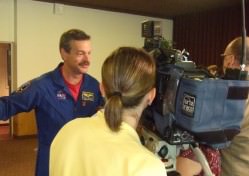[/caption]
Astronaut Scott Altman, commander of the recent servicing mission to the Hubble Space Telescope said the independent review of NASA’s current plans is allowing both the space agency and the nation to step back, contemplate and plan the future. “The new administration wants to take a good hard look at the direction of future of the space program and I endorse that,” Altman said. I think we’ll come out of this with a more focused and hopefully a stronger movement forward. And the folks working on Constellation have the chance to take a breath while the Augustine Commission is at work and I’m looking forward to hearing what they have to say.”
Altman made his comments during a visit to the Lakeview Museum of Arts and Sciences in Peoria, Illinois, a place he visited as a child, which he said inspired him to “reach for the stars.”
The veteran astronaut worked on helping to develop the Constellation program before he was assigned to the Hubble servicing mission, and he looks forward to returning to that task, whether it be the Ares and Orion vehicles or another incarnation of the next space vehicles. When asked about his future plans, Altman said. “I think I will go back and work on the next generation vehicle as we work those designs. Will I get to stick around and maybe fly them? I don’t know, that’s another five or six years — we’ll see. But I’m loving what I’m doing and it’s great to be an astronaut at NASA.”

The Augustine Commission is holding an open meeting on Tuesday in Houston, and another on July 29 in Huntsville, Alabama, to allow public input on the course NASA should be taking. Altman likes that the Commission is readily taking public comment.
“It’s always good,” he said. “The space program is a manifestation of the country’s national will, what we want to do. I think it is important that NASA stay connected with people. There should be a place where the public can let NASA know how they think we’re doing. And we (NASA) need to make sure we let them know what we are doing, so we need to make sure the communication goes both ways.”
Hubble Images of Jupiter Impact Site
Altman was asked if he had seen the first Hubble image released to the public since the servicing mission, a surprise observation of the recent impact on Jupiter. “The pictures they took of Jupiter were awesome,” he said “The other great thing about seeing those pictures is that we know our repairs worked, so it’s nice to see the success of our mission.”
The Wide Field Camera 3, which took the Jupiter image, was one of the first tasks for Altman and his STS-125 crew to repair, and the repair provided some initial drama for the mission. “I thought it wasn’t going to come out,” he said. “We came so close to being stuck with our very first thing not working out but I was thrilled when the old camera came out and the new went in. And now to hear that it’s working they way it should, we’re all thrilled.”
Altman said he and his crew were able to see other new images taken by the refurbished Hubble Space Telescope while at a visit to the Space Telescope Science Institute last week, and hinted the images may be released to the public soon. “We did get a sneak peak at some of the images they are starting to take and I think when they have an early release of them, you should all watch because it’s going to be incredible,” he said.
Mission Memories
Altman said the most memorable part of the STS-125 mission was when crewmate Mike Massimino had to tear a handle off the telescope in order to proceed with the repair of the STIS instrument. Massimino and spacewalking partner Michael Good spent hours struggling to remove a stuck bolt from a handrail on the telescope. Finally mission control told Massimino to just tear the handrail off.
“I was with the rest of the crew at the edge of the window looking out when Mike broke the handle off,” said Altman. “That was pretty amazing to watch. But I think it shows the benefit of having people in space who can respond to things that you didn’t think were going to happen.”

Altman presented the museum with pictures and an item he flew in space. “When we fly in space we are able to take a few things with us,” he said. “One of the things that I took along was this Illinois flag. So it’s got 5.3 million miles on it, 197 orbits, but no frequent flyer miles! But I wanted to present it to the museum along with a few pictures from the mission as a way of saying thanks for the inspiration that started here for me, and starts for so many other people. And, as you kids here look to follow your dreams and reach for the stars, you never really know where you might end up, but there are some pretty cool places out there that you might visit, I know I have. It’s really an honor for me to be back here. I’m so thrilled and I just want to say thank you to the museum for the great work that you do, and I know you’re about to do a lot more in the near future in the new facility.
The Lakeview Museum will be part of a new 81,000-square-foot Peoria Riverfront Museum that will feature a 3-D IMAX Theatre, state-of-the-art planetarium, and other educational and cultural activities.

One small correction, the new camera installed on Hubble is the Wide Field Camera 3 (WFC 3) sans ‘Planetary’. 🙂
Thanks Jon!